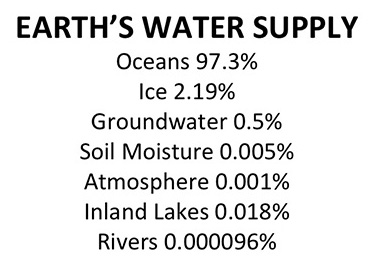Water Supply
Students observe the change of water states as it moves through the water cycle.
Background
Lesson Activities
Recommended Companion Resources
Credits
Author
Debra Spielmaker | National Center for Agricultural Literacy (NCAL)
Acknowledgements
- Activity 1 was adapted from California Department of Water Resources.
- Activity 2 of this lesson is found on many websites, and the original author or source is unknown.
Standards
Texas Content Area Standards
-
Science: 3.112.14.b.5
Matter and energy. The student knows that matter has measurable physical properties and those properties determine how matter is classifies, changed, and used.
- Science: 3.112.14.b.5.B: The student is expected to describe and classify samples of matter as solids, liquids, and gases and demonstrate that solids have a definite shape and that liquids and gases take the shape of their container.
- Science: 3.112.14.b.5.C: The student is expected to predict, observe, and record changes in the state of matter caused by heating or cooling such as ice becoming liquid water, condensation forming on the outside of a glass of ice water, or liquid water being heated to the point of becoming water vapor.
-
Science: 4.112.15.b.5
Matter and energy. The student knows that matter has measurable physical properties and those properties determine how matter is classifies, changed, and used.
- Science: 4.5.A: The student is expected to measure, compare, and contrast physical properties of matter, including mass, colume, states (solid, liquid, gas), temperature, magnetism, and the ability to sink or float.
-
Science: 4.112.15.b.8
Earth and space. The student knows that there are recognizable patterns in the natural world and among the Sun, Earth, and Moon system.,
- Science: 4.8.B: The student is expected to describe and illustrate the continuous movement of water above and on the surface of Earth through the water cycle and explain the role of the Sun as a major source of energy in this process.
-
Science: 5.112.15.b.8
Earth and space. The student knows that there are recognizable patterns in the natural world and among the Sun, Earth, and Moon.
- Science: 5.8.B: The student is expected to explain how the Sun and the ocean interact in the water cycle.
-
Science: 3.112.5.b.6
Matter and energy. The student knows that matter has measurable physical properties that determine how matter is identified, classified, changed, and used. The student is expected to:
- Science: 3.112.5.b.6.B: describe and classify samples of matter as solids, liquids, and gases and demonstrate that solids have a definite shape and that liquids and gases take the shape of their container
- Science: 3.112.5.b.6.C: predict, observe, and record changes in the state of matter caused by heating or cooling in a variety of substances such as ice becoming liquid water, condensation forming on the outside of a glass, or liquid water being heated to the point of becoming water vapor (gas)
-
Science: 4.112.6.b.6
Matter and energy. The student knows that matter has measurable physical properties that determine how matter is identified, classified, changed, and used. The student is expected to:
- Science: 4.112.6.b.6.A: classify and describe matter using observable physical properties, including temperature, mass, magnetism, relative density (the ability to sink or float in water), and physical state (solid, liquid, gas)
-
Science: 5.112.7.b.10
Earth and space. The student knows that there are recognizable patterns and processes on Earth. The student is expected to:
- Science: 5.112.7.b.10.A: explain how the Sun and the ocean interact in the water cycle and affect weather
 Organize students into groups of two and explain the directions for the Water Cycle in a Cup activity. Review key vocabulary that are labeled on the
Organize students into groups of two and explain the directions for the Water Cycle in a Cup activity. Review key vocabulary that are labeled on the 